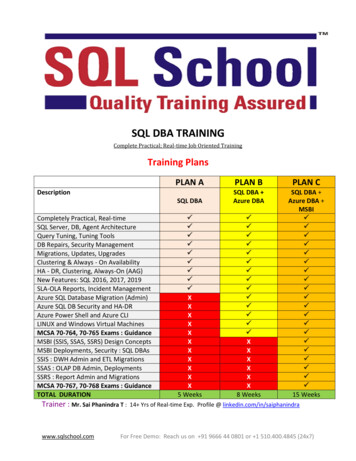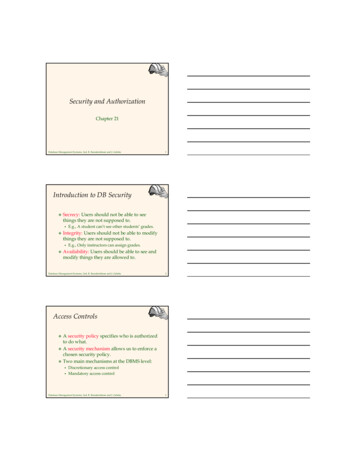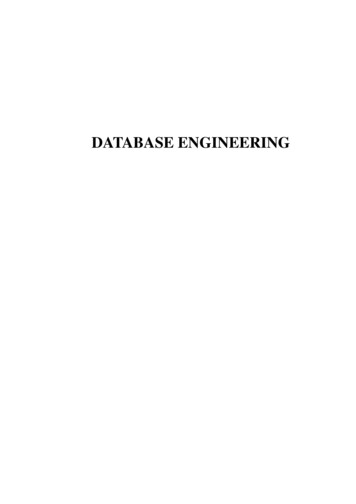
Transcription
DATABASE ENGINEERING
DATABASE ENGINEERINGLECTURE NOTESPrepared byDr. Subasish MohapatraDepartment of Computer Science and ApplicationCollege of Engineering and Technology, BhubaneswarBiju Patnaik University of Technology, Odisha
SYLLABUSCourse Code: PCCS4204Subject Name: DataBase Engineering Credit:4Module1: (12 Hrs)Introduction to database Systems, Basic concepts &Definitions, Data Dictionary, DBA, File-orientedsystem vs. Database System, Database Language.Database System Architecture-Schemas, Sub Schemas & Instances, 3-level database architecture, DataAbstraction, Data Independence, Mappings, Structure, Components & functions of DBMS, Datamodels, Mapping E-R model to Relational, Network and Object Oriented Data models, types ofDatabase systems,Storage Strategies: Detailed Storage Architecture, Storing Data, Magnetic Disk, RAID, Other Disks,Magnetic Tape, Storage Access, File & Record Organization, File Organizations & Indexes, OrderIndices, B Tree Index Files, HashingModule2: (16 Hrs)Relational Algebra, Tuple & Domain Relational Calculus, Relational Query Languages: SQL and QBE.Database Design :-Database development life cycle(DDLC),Automated design tools, Functionaldependency and Decomposition, Dependency Preservation & lossless Design, Normalization, Normalforms:1NF, 2NF,3NF,and BCNF, Multi-valued Dependencies, 4NF & 5NF.Query processing and optimization: Evaluation of Relational Algebra Expressions, Query optimization.Module3: (12 Hrs)Transaction processing and concurrency control: Transaction concepts, concurrency control, locking andTimestamp methods for concurrency control.Database Recovery System: Types of Data Base failure & Types of Database Recovery, RecoverytechniquesAdvanced topics: Object-Oriented & Object – Relational Database, Parallel & Distributed Database,Introduction to Data warehousing & Data MiningText Books:1. Database System Concepts by Sudarshan, Korth (McGraw-Hill Education)2. Fundamentals of Database System By Elmasari &Navathe- Pearson EducationReferences Books:(1) An introduction to Database System – Bipin Desai, Galgotia Publications(2) Database System: concept, Design & Application by S.K.Singh (Pearson Education)(3) Database management system by leon &leon (Vikas publishing House).(4) Database Modeling and Design: Logical Design by Toby J. Teorey, Sam S. Lightstone, and TomNadeau, “”, 4th Edition, 2005, Elsevier India Publications, New Delhi(5) Fundamentals of Database Management System – Gillenson, Wiley India
CONTENTSLECTURE-1: Introduction to DataLECTURE-2: DBMSLECTURE-3: 3 level Architecture of DBMSLECTURE-4: Elements of DBMSLECTURE-5: ER-MODELLECTURE-6: ER-DIAGRAM:LECTURE-7: Advanced ER-Diagram:LECTURE-8: Conversion of ER-Diagram to Relational DatabaseLECTURE-9: Record Based Logical ModelLECTURE-10: RELATIONAL MODELLECTURE-11: CONSTRAINTSLECTURE-12: FILE ORGANISATIONLECTURE-13: INDEXLECTURE-14: Clustering IndexLECTURE-15: B Tree IndexLECTURE-16: Hash File OrganizationLECTURE-17: Query ProcessingLECTURE-18: Evaluation of ExpressionsLECTURE-19 Relational AlgebraLECTURE-20 Additional OperationsLECTURE-21 Tuple Relational CalculusLECTURE-22 Structured Query Language (SQL)LECTURE-23 Nested Sub queriesLECTURE-24 Integrity ConstraintsLECTURE-25 Query by Example (QBE)LECTURE-26 Relational Database DesignLECTURE-27 Closure of a set of Functional DependenciesLECTURE-28 Loss less DecompositionLECTURE-29 NormalizationLECTURE-30 Boyce-Code Normal Form (BCNF)LECTURE-31 Query ProcessingLECTURE-32 Query OptimizationLECTURE-33 TransactionLECTURE-34 Problems due to lockingLECTURE-35 Multiversion Technique Based on Timestamp OrderingLECTURE-36 SerializabilityLECTURE-37 Object Oriented DatabasesLECTURE-38 Parallel Database
Module-1:LECTURE-1: Introduction to DataIntroduction:In computerized information system data are the basic resource of the organization. So, properorganization and management for data is required for organization to run smoothly. Databasemanagement system deals the knowledge of how data stored and managed on a computerizedinformation system. In any organization, it requires accurate and reliable data for better decisionmaking, ensuring privacy of data and controlling data efficiently.The examples include deposit and/or withdrawal from a bank, hotel, airline or railway reservation,purchase items from supermarkets in all cases, a database is accessed.What is data?Data are the known facts or figures that have implicit meaning. It can also be defined as it is therepresentation of facts, concepts or instructions in a formal manner, which is suitable forunderstanding and processing. Data can be represented in alphabets (A-Z, a-z), digits (0-9) andusing special characters ( ,-.#, , etc)e.g: 25, “ajit” etc.Information:Information is the processed data on which decisions and actions are based. Information can bedefined as the organized and classified data to provide meaningful values.Eg: “The age of Ravi is 25”File:File is a collection of related data stored in secondary memory.File Oriented Approach:The traditional file oriented approach to information processing each application has a separatemaster file and its own set of personal file. In file oriented approach the program dependent on thefiles and files dependent upon the programs.Disadvantages of file oriented approach:1) Data redundancy and inconsistency:The same information may be written in several files. This redundancy leads to higherstorage and access cost. It may lead data inconsistency that is the various copies of the samedata may present at multiple places for example a changed customer address may bereflected in single file but not else where in the system.2) Difficulty in accessing data :The conventional file processing system do not allow data to be retrieved in a convenientand efficient manner according to user choice.3) Data isolation :Because data are scattered in various files and files may be in different formats with newapplication programs to retrieve the appropriate data is difficult.4)Integrity Problems:
Developers enforce data validation in the system by adding appropriate code in the variousapplication program. How ever when new constraints are added, it is difficult to change theprograms to enforce them.5) Atomicity:It is difficult to ensure atomicity in a file processing system when transaction failure occursdue to power failure, networking problems etc. (atomicity: either all operations of thetransaction are reflected properly in the database or non are)6) Concurrent access:In the file processing system it is not possible to access the same file for transaction at samethe time.7) Security problems:There is no security provided in file processing system to secure the data from unauthorized user access.
LECTURE-2: DBMSDatabase:A database is organized collection of related data of an organization stored in formatted way whichis shared by multiple users.The main feature of data in a database are:1. It must be well organized2. It is related3. It is accessible in a logical order without any difficulty4. It is stored only onceFor example consider the roll no, name, address of a student stored in a student file. It is collectionof related data with an implicit meaning. Data in the database may be persistent, integrated andshared.Persistent:If data is removed from database due to some explicit request from user to remove.Integrated:A database can be a collection of data from different files and when any redundancy among thosefiles are removed from database is said to be integrated data.Sharing Data:The data stored in the database can be shared by multiple users simultaneously without affecting thecorrectness of data.Why Database:In order to overcome the limitation of a file system, a new approach was required. Hence a databaseapproach emerged. A database is a persistent collection of logically related data. The initial attemptswere to provide a centralized collection of data. A database has a self describing nature. It containsnot only the data sharing and integration of data of an organization in a single database.A small database can be handled manually but for a large database and having multiple users it isdifficult to maintain it. In that case a computerized database is useful.The advantages of database system over traditional, paper based methods of record keeping are: Compactness: No need for large amount of paper files Speed: The machine can retrieve and modify the data more faster way then human being Less drudgery: Much of the maintenance of files by hand is eliminated Accuracy: Accurate, up-to-date information is fetched as per requirement of the user at anytime.Database Management System (DBMS):A database management system consists of collection of related data and refers to a set of programsfor defining, creation, maintenance and manipulation of a database.
Function of DBMS:1. Defining database schema: it must give facility for defining the database structure alsospecifies access rights to authorized users.2. Manipulation of the database: The dbms must have functions like insertion of record intodatabase, updation of data, deletion of data, retrieval of data3. Sharing of database: The DBMS must share data items for multiple users by maintainingconsistency of data.4. Protection of database: It must protect the database against unauthorized users.5. Database recovery: If for any reason the system fails DBMS must facilitate data baserecovery.Advantages of DBMS:Reduction of redundancies:Centralized control of data by the DBA avoids unnecessary duplication of data and effectivelyreduces the total amount of data storage required avoiding duplication in the elimination of theinconsistencies that tend to be present in redundant data files.Sharing of Data:A database allows the sharing of data under its control by any number of application programs orusers.Data Integrity:Data integrity means that the data contained in the database is both accurate and consistent.Therefore data values being entered for storage could be checked to ensure that they fall with in aspecified range and are of the correct format.Data Security:The DBA who has the ultimate responsibility for the data in the dbms can ensure that proper accessprocedures are followed including proper authentication to access to the DataBase System andadditional check before permitting access to sensitive data.Conflict Resolution:DBA resolve the conflict on requirements of various user and applications. The DBA chooses thebest file structure and access method to get optional performance for the application.Data Independence:Data independence is usually considered from two points of views; physically data independenceand logical data independence.Physical Data Independence allows changes in the physical storage devices or organization of thefiles to be made without requiring changes in the conceptual view or any of the external views andhence in the application programs using the data base.Logical Data Independence indicates that the conceptual schema can be changed without affectingthe existing external schema or any application program.
Disadvantage of DBMS:1. DBMS software and hardware (networking installation) cost is high2. The processing overhead by the dbms for implementation of security, integrity and sharing ofthe data.3. Centralized database control4. Setup of the database system requires more knowledge, money, skills, and time.5. The complexity of the database may result in poor performance.
LECTURE-3: 3 level Architecture of DBMSDatabase Basics:Data Item:The data item is also called as field in data processing and is the smallest unit of data that hasmeaning to its users.Eg: “e101”, ”sumit”Entities and attributes:An entity is a thing or object in the real world that is distinguishable from all other objectsEg: Bank, employee, studentAttributes are properties are properties of an entity.Eg: Empcode, ename, rolno, nameLogical data and physical data :Logical data are the data for the table created by user in primary memory.Physical data refers to the data stored in the secondary memory.Schema and sub-schema :A schema is a logical data base description and is drawn as a chart of the types of data that are used.It gives the names of the entities and attributes and specify the relationships between them.A database schema includes such information as : Characteristics of data items such as entities and attributes .Logical structures and relationships among these data items .Format for storage representation.Integrity parameters such as physical authorization and back up policies.A subschema is derived schema derived from existing schema as per the user requirement. Theremay be more then one subschema create for a single conceptual schema.Three Level Architecture of DBMS :External SConceptualMappingInternal levelsuppliedViewUser nsuppliedbyviewDBMS/OSInternal level
A database management system that provides three level of data is said to follow three-levelarchitecture . External level Conceptual level Internal levelExternal Level :The external level is at the highest level of database abstraction . At this level, there will be manyviews define for different users requirement. A view will describe only a subset of the database. Anynumber of user views may exist for a given global schema(coneptual schema).For example, each student has different view of the time table. the view of a student of BTech(CSE) is different from the view of the student of Btech (ECE). Thus this level of abstraction isconcerned with different categories of users.Each external view is described by means of a schema called sub schema.Conceptual Level :At this level of database abstraction all the database entities and the relationships among them areincluded. One conceptual view represents the entire database. This conceptual view is defined bythe conceptual schema.The conceptual schema hides the details of physical storage structures and concentrate ondescribing entities, data types, relationships, user operations and constraints.It describes all the records and relationships included in the conceptual view. There is only oneconceptual schema per database. It includes feature that specify the checks to relation dataconsistency and integrity.Internal level :It is the lowest level of abstraction closest to the physical storage method used. It indicates how thedata will be stored and describes the data structures and access methods to be used by the database.The internal view is expressed by internal schema.The following aspects are considered at this level:1. Storage allocation e.g: B-tree, hashing2. Access paths eg. specification of primary and secondary keys, indexes etc3. Miscellaneous eg. Data compression and encryption techniques, optimization of the internalstructures.Database Users :Naive Users :Users who need not be aware of the presence of the database system or any other system supportingtheir usage are considered naïve users . A user of an automatic teller machine falls on this category.
Online Users :These are users who may communicate with the database directly via an online terminal orindirectly via a user interface and application program. These users are aware of the databasesystem and also know the data manipulation language system.Application Programmers :Professional programmers who are responsible for developing application programs or userinterfaces utilized by the naïve and online user falls into this category.Database Administration :A person who has central control over the system is called database administrator .The function of DBA are :1. Creation and modification of conceptual Schema definition2. Implementation of storage structure and access method.3. Schema and physical organization modifications .4. Granting of authorization for data access.5. Integrity constraints specification.6. Execute immediate recovery procedure in case of failures7. Ensure physical security to databaseDatabase language :1) Data definition language (DDL) :DDL is used to define database objects .The conceptual schema is specified by a set ofdefinitions expressed by this language. It also gives some details about how to implementthis schema in the physical devices used to store the data. This definition includes all theentity sets and their associated attributes and their relationships. The result of DDLstatements will be a set of tables that are stored in special file called data dictionary.2) Data Manipulation Language (DML) :A DML is a language that enables users to access or manipulate data stored in the database.Data manipulation involves retrieval of data from the database, insertion of new data into thedatabase and deletion of data or modification of existing data.There are basically two types of DML: Procedural: Which requires a user to specify what data is needed and how to get it. Non-Procedural: which requires a user to specify what data is needed with outspecifying how to get it.3) Data Control Language (DCL):This language enables user to grant authorization and canceling authorization of databaseobjects.
LECTURE-4: Elements of DBMSElements of DBMS:DML Pre-Compiler:It converts DML statements embedded in an application program to normal procedure calls in thehost language. The pre-complier must interact with the query processor in order to generate theappropriate code.DDL Compiler:The DDL compiler converts the data definition statements into a set of tables. These tables containsinformation concerning the database and are in a form that can be used by other components of thedbms.File Manager:File manager manages the allocation of space on disk storage and the data structure used torepresent information stored on disk.Database Manager:A database manager is a program module which provides the interface between the low level datastored in the database and the application programs and queries submitted to the system.The responsibilities of database manager are:1.Interaction with File Manager: The data is stored on the disk using the file system whichis provided by operating system. The database manager translate the different DMLstatements into low-level file system commands so the database manager is responsible forthe actual storing, retrieving and updating of data in the database.2.Integrity Enforcement: The data values stored in the database must satisfy certainconstraints (eg: the age of a person can't be less then zero). These constraints are specifiedby DBA. Data manager checks the constraints and if it satisfies then it stores the data in thedatabase.3.Security Enforcement: Data manager checks the security measures for database fromunauthorized users.4.Backup and Recovery: Database manager detects the failures occur due to differentcauses (like disk failure, power failure, deadlock, software error) and restores the databaseto original state of the database.5.Concurrency Control: When several users access the same database file simultaneously,there may be possibilities of data inconsistency. It is responsible of database manager tocontrol the problems occur for concurrent transactions.Query Processor:The query processor used to interpret to online user’s query and convert it into an efficient series ofoperations in a form capable of being sent to the data manager for execution. The query processor
uses the data dictionary to find the details of data file and using this information it create queryplan/access plan to execute the query.Data Dictionary:Data dictionary is the table which contains the information about database objects. It containsinformation like1. external, conceptual and internal database description2. description of entities, attributes as well as meaning of data elements3. synonyms, authorization and security codes4. database authorizationThe data stored in the data dictionary is called meta data.DBMS STRUCTURE:Naïve userApplicationprogramersApplicationprogramsSystem callsApplication progobj codeDml precomplierOn line userDBADdl compilerQuery processorDdl compilerDatabase managerFile managerDBMSData fileData dictionaryQue: List four significant differences between a File-Processing System and a DBMS.Ans: Some major differences between a database management system and a file-processing systemare: Both systems contain a collection of data and a set of programs which access that data. Adatabase management system coordinates both the physical and the logical access to thedata, whereas a file-processing system coordinates only the physical access.
A database management system reduces the amount of data duplication by ensuring that aphysical piece of data is available to all programs authorized to have access to it, where asdata written by one program in a file-processing system may not be readable by anotherprogram. A database management system is designed to allow flexible access to data (i.e., queries),whereas a file-processing system is designed to allow predetermined access to data (i.e.,compiled programs). A database management system is designed to coordinate multiple users accessing the samedata at the same time. A file-processing system is usually designed to allow one or moreprograms to access different data files at the same time. In a file-processing system, a filecan be accessed by two programs concurrently only if both programs have read-only accessto the file.Que: Explain the difference between physical and logical data independence.Ans: Physical data independence is the ability to modify the physical scheme without making itnecessary to rewrite application programs. Such modifications include changing fromunblocked to blocked record storage, or from sequential to random access files. Logical data independence is the ability to modify the conceptual scheme without making itnecessary to rewrite application programs. Such a modification might be adding a field to arecord; an application program’s view hides this change from the program.Que: List five responsibilities of a database management system. For each responsibility, explainthe problems that would arise if the responsibility were not discharged.Ans: A general purpose database manager (DBM) has five responsibilities:a. interaction with the file manager.b. integrity enforcement.c. security enforcement.d. backup and recovery.e. concurrency control.If these responsibilities were not met by a given DBM (and the text points out that sometimes aresponsibility is omitted by design, such as concurrency control on a single-user DBM for a microcomputer) the following problems can occur, respectively:a. No DBM can do without this, if there is no file manager interaction then nothing stored inthe files can be retrieved.b. Consistency constraints may not be satisfied, when account balances could go below theminimum allowed, employees could earn too much overtime (e.g.,hours 80) or, airlinepilots may fly more hours than allowed by law.c. Unauthorized users may access the database, or users authorized to access part of the
database may be able to access parts of the database for which they lack authority. Forexample, a high school student could get access to national defense secret codes, oremployees could find out what their supervisors earn.d. Data could be lost permanently, rather than at least being available in a consistent state thatexisted prior to a failure.e. Consistency constraints may be violated when intgrity constraints failed in a transaction. Forexample, incorrect bank balances might be reflected due to simultaneous withdrawals anddeposits, and so on.Que. What are five main functions of a database administrator?Ans: Five main functions of a database administrator are: To create the scheme definitionTo define the storage structure and access methodsTo modify the scheme and/or physical organization when necessaryTo grant authorization for data accessTo specify integrity constraintsQue: List six major steps that you would take in setting up a database for a particular enterprise.Ans: Six major steps in setting up a database for a particular enterprise are: Define the high level requirements of the enterprise (this step generates a document knownas the system requirements specification.) Define a model containing all appropriate types of data and data relationships. Define the integrity constraints on the data. Define the physical level. For each known problem to be solved on a regular basis (e.g., tasks to be carried out byclerks or Web users) define a user interface to carry out the task, and write the necessaryapplication programs to implement the user interface. Create/initialize the database.EXERCISE:1. What is database management system?2. What are the disadvantage of file processing system?3. State advantage and disadvantage of database management system.4. What are different types of database users?5. What is data dictionary and what are its contents?6. What are the functions of DBA?7. What are the different database languages? Explain with example.8. Explain the three layer architecture of DBMS.9. Differentiate between physical data independence and logical data independence.10. Explain the functions of database manager.11. Explain meta data.
LECTURE-5: ER-MODELData Model:The data model describes the structure of a database. It is a collection of conceptual tools fordescribing data, data relationships and consistency constraints and various types of data modelssuch as1. Object based logical model2. Record based logical model3. Physical modelTypes of data model:1. Object based logical modela. ER-modelb. Functional modelc. Object oriented modeld. Semantic model2. Record based logical modela. Hierarchical database modelb. Network modelc. Relational model3. Physical modelEntity Relationship Model (ER Model)The entity-relationship data model perceives the real world as consisting of basic objects, calledentities and relationships among these objects. It was developed to facilitate database design byallowing specification of an enterprise schema which represents the overall logical structure of adata base.Main Features of ER-MODEL: Entity relationship model is a high level conceptual model It allows us to describe the data involved in a real world enterprise in terms of objects andtheir relationships. It is widely used to develop an initial design of a database It provides a set of useful concepts that make it convenient for a developer to move from abasic set of information to a detailed and description of information that can be easilyimplemented in a database system It describes data as a collection of entities, relationships and attributes.Basic Concepts:The E-R data model employs three basic notions : entity sets, relationship sets and attributes.Entity Sets:An entity is a “thing” or “object” in the real world that is distinguishable from all other objects. Forexample, each person in an enterprise is an entity. An entity has a set properties and the values forsome set of properties may uniquely identify an entity. BOOK is entity and its properties (called asattributes) bookcode, booktitle, price etc.An entity set is a set of entities of the same type that share the same properties, or attributes. The set
of all persons who are customers at a given bank.Attributes:An entity is represented by a set of attributes. Attributes are descriptive properties possessed byeach member of an entity set.Customer is an entity and its attributes are customerid, custmername, custaddress etc.An attribute as used in the E-R model, can be characterized by the following attribute types.a) Simple and Composite Attribute:Simple attributes are the attributes which can’t be divided into sub parts, e.g. customerid, empnoComposite attributes are the attributes which can be divided into subparts, e.g. name consisting offirst name, middle name, last name and address consisting of city, pincode, state.b) Single-Valued and Multi-Valued Attribute:The attribute having unique value is single –valued attribute, e.g. empno, customerid, regdno etc.The attribute having more than one value is multi-valued attribute, eg: phone-no, dependent name,vehicle.c) Derived Attribute:The values for this type of attribute can be derived from the values of existing attributes, e.g. agewhich can be derived from currentdate – birthdate and experience in year can be calculated ascurrentdate-joindate.d) NULL Valued Attribute:The attribute value which is not known to user is called NULL valued attribute.Relationship Sets:A relationship is an association among several entities. A relationship set is a set of relationships ofthe same type. Formally, it is a mathematical relation on n 2 entity sets. If E 1, E2 En are entitysets, then a relation ship set R is a subset of{(e1,e2, en) e1Є E1, e2 Є E2., en Є En}where (e1,e2, en) is a relation ship.customerborrowloanConsider the two entity sets customer and loan. We define the relationship set borrow to denote theassociation between customers and the bank loans that the customers have.Mapping Cardinalities:Mapping cardinalities or cardinality ratios, express the number of entities to which another entitycan be associated via a relationship set. Mapping cardinalities are most useful in describing binaryrelationship sets, although they can contribute to the description of relationship sets that involvemore than two entity sets. For a binary relationship set R between entity sets A and B, the mapping
cardinalities must be one of the following:1. One to One:An entity in A is associated with at most one entity in B, and an entity in B is associated with atmost one entity in A.Eg: relationship between college and principal11collegeprincipalhas2. One to Many:An entity in A is associated with any number of entities in B. An entity in B is associated with at themost one entity in A.Eg: Relationship between department and faculty1MDepar
Disadvantage of DBMS: 1. DBMS software and hardware (networking installation) cost is high 2. The processing overhead by the dbms for implementation of security, integrity and sharing of the data. 3. Centralized database control 4. Setup of the database sy
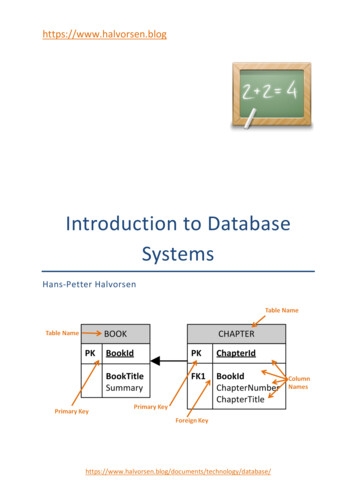
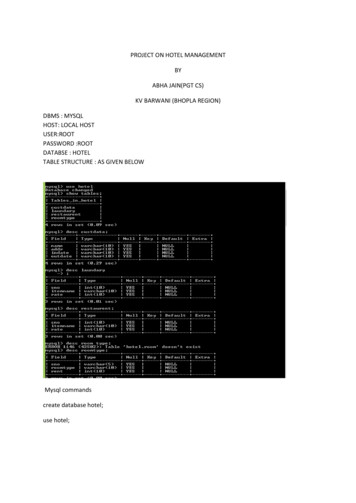
![Database Management System [DBMS] Tutorial](/img/2/dbms-tutorial.jpg)


